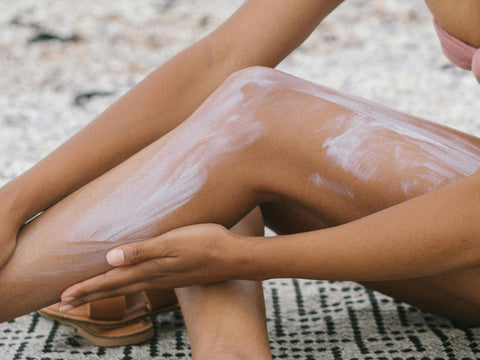May is Skin Cancer Awareness month and so this blog will cover different types of skin cancer, causes and what you can do to protect your skin.
There are three types of skin cancer. Non-melanoma skin cancers are basal cell carcinoma and squamous cell carcinoma, they are more common than melanoma. Melanoma is a more serious skin cancer as it can spread to other parts of the body.
In the UK, there are around 147,000 new cases of non-melanoma skin cancer diagnosed each year, and around 16,700 cases for melanoma. Around 86% of skin cancer cases are preventable.

What are the causes of skin cancer?
Most cases of skin cancer are caused by exposure to ultraviolet (UV) rays. UV ray exposure is either from the sun or from sunbeds/tanning booths.
Sun damage is shown by our skin through sunburns, reddening of the skin, peeling, and tanning. A tan from UV rays is a sign that our skin has been harmed.
When UV rays penetrate our skin, they damage the DNA in our skin cells, this damage is irreparable and builds up over time, even once the tan disappears, the damage is still there. This damage increases our risk of developing all types of skin cancer.
It has been found that those who use tanning booths/sunbeds have a higher risk of skin cancer.
What are the two types of UV rays?
There are UVA and UVB rays. UVB rays are the ones that cause sunburn, which we can see and feel. Whereas UVA rays penetrate deeper into the skin, UVA rays are the ones which are responsible for sun damage, wrinkles, and premature ageing. It’s important to note that both UVA and UVB rays can cause skin cancer.

Why use sunscreen?
Sunscreen is used to help prevent UV rays from penetrating the skin and damaging skin cells. By using a sunscreen, we can help to reduce the risk of the impact of both UVA and UVB rays.
Fairer skin that is more prone to burning and freckles in the sun are at a higher risk for skin cancer, however anyone can still get skin cancer, so it’s important to protect your skin regardless.
Using the correct amount of SPF
It’s important to ensure that you use the correct amount of sunscreen. When they are tested a specific amount of the sunscreen is used, if you use less than this it means that you may not get sufficient protection from UV rays.
When applying sunscreen, it is important to apply the correct amount, and make sure that you cover areas which are frequently missed (neck, ears, feet and back). It is recommended that you apply 6-8 teaspoons of sunscreen to cover an adult body, over half a teaspoon for each arm and for your face and neck, over one teaspoon for each leg, front of body and back

Importance of sunscreen
- It is important to make sure that you use an SPF which is at least a 30 and has UVA protection either through the logo or star rating
- Apply to clean and dry skin
- Apply 20-30minutes before sun exposure
- Reapply every 2 hours, especially after swimming, towelling dry or sweating a lot
Other ways to protect your skin
- Wear protective clothing that covers you, including a hat and sunglasses
- Stay in the shade and avoid the midday sun (from 11am-3pm)
- Avoid tanning booths / sunbeds

Check your skin
It is important to check your skin regularly, if you are concerned about any moles which have changed in any way, please contact your GP or dermatologist.
What to look for:
- A new mole (pigmented or non-pigmented)
- Changes in colour or multicoloured
- Changes in shape or size
- Starts to itch, bleed or crusting
- Has an irregular, scalloped or poorly defined border
- Asymmetrical in shape
More blogs on UV Rays and Skin Health:
- Importance of SPF
- UV Rays and Skin Health
- What Increases Exposure to UV Rays
- 10 Reasons Why you need to Lucy Bee SPF
- 6 Essential Rules of SPF
- Do Moisturisers or BB Creams with SPF Offer Enough Protection
- What is the Difference Between Chemical and Mineral SPFs
- What Tests have been Carried out on the SPF 30 Face Serum

